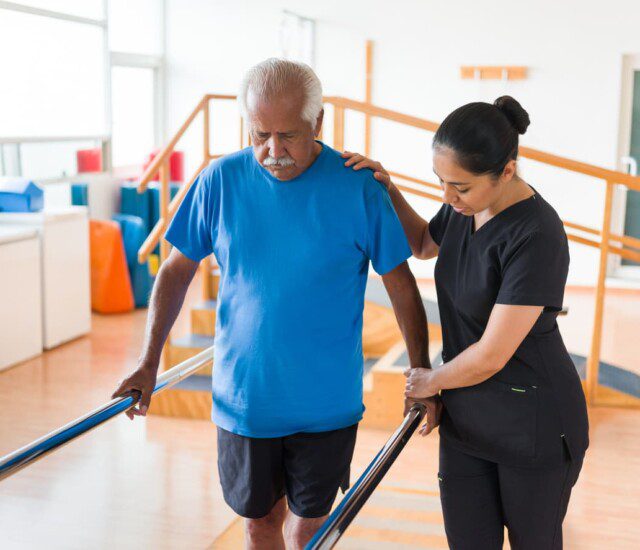For many people, occupational therapy (OT) conjures images of recovering from serious surgery or stroke. And while certified occupational therapists are trained and highly skilled at helping individuals recover from both of those situations, there are many more scenarios where they can help older adults reduce pain and improve their daily routines.
At Oak Trace, our goal is for residents to maintain their greatest level of independence while having the highest quality of life. That is the goal of occupational therapists as well. Some common ways OT providers can make aging easier include treatment and education for:
- Range of motion
- Cognitive decline
- Arthritis
- Fall Prevention
- Stroke Recovery
- Vision Loss
Range of Motion
Range of motion (ROM) is the degree of movement available in a particular joint — like the hip, knee, elbow and wrist. A certain degree of range of motion in your joints is required to comfortably complete daily tasks. ROM might decrease naturally due to age, injury, surgery or another condition. When range of motion is limited, activities of daily living such as dressing or bathing can be painful or difficult and even lead to further complications. If you find that your range of motion isn’t what it used to be, an Oak Trace Occupational Therapist can help.
Your occupational therapist will work with you to establish goals and a treatment plan to help maintain or even improve range of motion. Treatments might include neuromuscular re-education, exercises, splints and ultrasound.
Cognitive Decline
According to the CDC, 11.7 percent of adults 65 and older have some form of subjective cognitive decline, which ranges from mild cognitive impairment to more serious cases of dementia. For individuals with mild cognitive impairment or those in the early stages of Alzheimer’s, occupational therapy offers education and environmental modifications to prolong independence and improve safety. In the middle stages of Alzheimer’s, occupational therapists can provide additional support and education to caregivers regarding safe transfers and emotional stimulation.
As a Life Care community, should cognitive decline progress to the stage that memory care is required, those services and living arrangements are readily available on the Oak Trace campus at no additional cost to our residents.
OT for Arthritis
Occupational therapy can help reduce the pressure, discomfort and pain associated with arthritis, a condition experienced by 1 in 4 adults in the United States. Through the use of therapeutic exercise, pain management modalities, adaptive equipment and splinting and compression techniques, occupational therapists provide education, activities and environmental modifications that allow you to have more energy to continue doing the activities that bring you joy.
Fall Prevention
The National Council on Aging reports that in the United States, 1 in 4 adults over the age of 65 falls every year. Falls frequently occur in or around the home and many of them are preventable. Falling is not a normal part of the aging process, although an increased risk of falling is linked to many conditions seen in older adults, including arthritis, vision loss and cognitive decline, which is why it is important to see an OT provider for those conditions.
When it comes to fall prevention, an occupational therapist can help assess your environment to offer environmental and behavioral modifications that reduce the risk of falls, like improving lighting or forming safer new habits around the home.
Stroke Recovery
Following a stroke, an occupational therapist can not only work with the affected individual to safely improve their occupations and independence, but also help ease the caregiver burden in doing so. While the effects of a stroke differ from person to person, OT providers take a holistic approach to treatment, and are trained in addressing the physical, cognitive and emotional challenges of recovery. Treatment might include cognitive rehabilitation, encouragement of your skill level, education and instruction on adaptive equipment and strength-building exercises. An occupational therapist will spend as much time as needed to help you return to your highest level of functioning and independence.
Vision Loss
Whether as a result of macular degeneration, glaucoma, stroke or another condition, vision loss in older adults can feel isolating and make daily tasks challenging. Occupational therapists can help you age in place, engage with your community and continue participating in the events and activities that you enjoy through task and environmental modifications, adaptive equipment and re-education.
Count on Oak Trace Health Services
Occupational therapy can assist with a myriad of other conditions older adults experience. OT is also used to aid in better sleep, as well as part of a palliative care or oncology plan. With the ultimate goal of reducing pain and maintaining independence, occupational therapy can be an integral component of your regular care plan. A report in the American Journal of Occupational Therapy cites “occupational therapy practitioners’ distinct knowledge of the significant impact that roles, habits, and routines have on health and wellness” as making their role in primary care valuable. Talk to your physician about incorporating occupational therapy into your care plan.
Certified occupational therapists in the Oak Trace health center work with residents in independent living, assisted living, skilled nursing and short-term rehab as well as older adults living in Downer’s Grove.
To learn more about Oak Trace occupational therapy and health services, please fill out the form below or call us at 630-769-6100.


